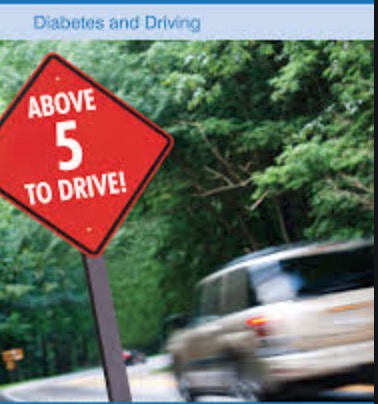Diabetes and Driving
The main concern with driving for people with diabetes is the presence of hypoglycemia, which is defined as low blood glucose (sugar). People with diabetes have to take extra precautions before driving, especially if they take medications (such as insulin, gliclazide, glyburide) that can cause low blood sugar. Low blood sugar can impair your reflexes and judgement and puts you and others on the road at risk
What are some of the symptoms of hypoglycemia?
- Some of the more common symptoms of low blood glucose are trembling, sweating, dizziness, anxiety, confusion, blurred vision, difficulty concentrating and nausea. Not all symptoms will be present and some people may have other or no symptoms at all.
- Symptoms are more likely to happen when your blood sugar is less than 4 mmol/L
What do I need to know before I get behind the wheel and drive?
- Test your blood glucose before driving
- If your blood glucose meters reads your glucose above 5, you’re OK to drive!
- If your blood glucose (sugar) is between 4 and 5 mmol/L, eat 15g of fast-acting carbohydrate. This is to bring your blood glucose over 5 and prevent a possible low blood sugar reaction. Eat a snack too if you’ll be driving for more than an hour
- If your blood glucose is under 4 mmol/L, don’t drive. Eat 15g of a fast-acting carbohydrate. Re-test your blood sugar. Wait at least 40 minutes (after sugar reaches 5) to drive because it takes time for judgement and the reflexes to your brain to recover fully from hypoglycemia
Other tips for drivers with diabetes:
- Don’t take chances with your (and other people’s) safety
- Plan ahead. Know how to prevent, recognize and treat a low blood sugar reaction. It is safer and more effective to prevent hypoglycemia than to treat it after it happens
- Check your blood sugar at least every 4 hours while driving
- Carry your blood glucose monitor in the car with you
- Have a “hypoglycemia treatment kit” in your car: some fast-acting sugar within easy reach such as glucose tablets, candy, regular soft drink or juice and a carbohydrate for a follow-up snack. Make sure they won’t freeze in the winter or spoil in the summer
- If you think your sugar is getting low while driving, pull over somewhere safe, stop driving and take the keys out of the ignition. Test your blood sugar and treat with fast-acting sugar if necessary. Wait at least 40 minutes (after your sugar is above 5) before you start driving again.
If you have any questions, please call to speak to one of our pharmacists. We’re here to help (905)-623-7611

